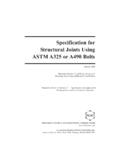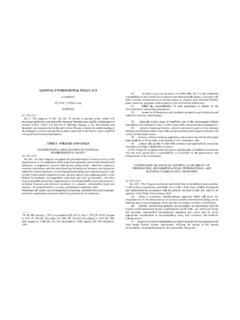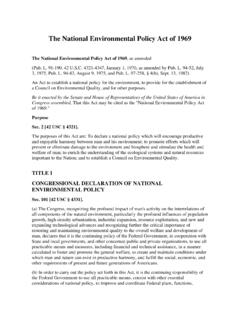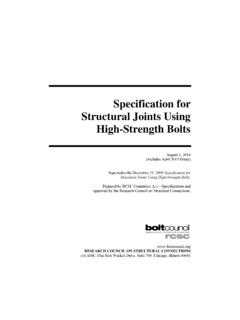Transcription of Specification for Structural Joints Using ASTM A325 or ...
1 Specification for Structural Joints Using ASTM A325 or A490 Bolts June 30, 2004 Supersedes the June 23, 2000 Specification for Structural Joints Using ASTM A325 or A490 by RCSC Committee Specifications and approved by the Research council on Structural Connections. RESEARCH council ON Structural CONNECTIONS c/o American Institute of Steel Construction, Inc. One East Wacker Drive, Suite 3100, Chicago, Illinois 60601-2001 ii Copyright 2004byResearch council on Structural Connections All rights reserved. This book or any part thereof must not be reproduced in any form without the written permission of the information presented in this publication has been prepared in accordance with recognized engineering principles and is for general information only. While it is believed to be accurate, this information should not be used or relied upon for anyspecific application without competent professional examination and verification of its accuracy, suitability, and applicability by a licensed engineer, architect or otherdesign professional.
2 The publication of the material contained herein is not intend-ed as a representation or warranty on the part of the Research council on StructuralConnections or of any other person named herein, that this information is suitable for any general or particular use or of freedom from infringement of any patent or patents. Anyone making use of this information assumes all liability arising fromsuch use. Caution must be exercised when relying upon other specifications and codes developed by other bodies and incorporated by reference herein since such material may be modified or amended from time to time subsequent to the printing of this edition. The Research council on Structural Connections bears no responsibility for such material other than to refer to it and incorporate it by reference at the time of the initial publication of this edition. Printed in the United States of AmericaSpecification for Structural Joints Using ASTM A325 or A490 Bolts, June 30, 2004 RESEARCH council ON Structural CONNECTIONS iii PREFACE The purpose of the Research council on Structural Connections (RCSC) is: (1) To stimulate and support such investigation as may be deemed necessary and valuable to determine the suitability, strength and behavior of various types of Structural connections; (2) To promote the knowledge of economical and efficient practices relating to such Structural connections; and, (3) To prepare and publish related standards and such other documents as necessary to achieving its purpose.
3 The council membership consists of qualified Structural engineers from academic and research institutions, practicing design engineers, suppliers and manufacturers of fastener components, fabricators, erectors and code-writing authorities. The first Specification approved by the council , called the Specification for Assembly of Structural Joints Using High Tensile Steel Bolts, was published in January 1951. Since that time the council has published fifteen successive editions. Each was developed through the deliberations and approval of the full council membership and based upon past successful usage, advances in the state of knowledge and changes in engineering design practice. This edition of the council s Specification for Structural Joints Using ASTM A325 or A490 Bolts continues the tradition of earlier editions. The major changes are: Sections , , and were editorially revised to clarify strength requirements of slip critical connections.
4 Section was modified to permit the use of A490 type bolts, with round heads equal or larger in diameter than ASTM F1852 heads, without F436 hardened washers. Table , footnote d, was added to clarify use of non-hardened plate washer to be used in conjunction with an ASTM F436 hardened washer. Commentary Table bolt head and nut dimension locations F and W as shown in the artwork Figure was corrected. In addition, typographical changes have been made throughout this Specification . By the Research council on Structural Connections, Raymond H. R. Tide Chairman Geoffrey L. Kulak Vice Chairman Emile W. J. Troup Secretary/Treasurer Abolhassan Astaneh-Asl Joseph G. Bahadrian Peter C. Birkemoe David W. Bogaty Charles J. Carter Helen Chen Robert J. Connor Nick E. Deal Robert J. Dexter Continued on page iv. Specification for Structural Joints Using ASTM A325 or A490 Bolts, June 30, 2004 RESEARCH council ON Structural CONNECTIONS iv Robert O.
5 Disque James M. Doyle G. Dean Droddy Edward R. Estes, Jr. John W. Fisher Karl H. Frank Michael C. Friel Rodney D. Gibble Michael I. Gilmor Gilbert Y. Grondin Roger D. Hamilton Allen J. Harrold Ian C. Hodgson Mark V. Holland Donald L. Johnson Charles E. Hundley Kaushik A. Iyer Peter F. Kasper Lawrence A. Kloiber Peter Kneen Richard F. Knoblock Chad M. Larson Daeyong Lee Jean-Claude Legault Kenneth B. Lohr Richard W. Marshall Jonathan C. McGormley David L. McKenzie Greg Miazga William A. Milek, Jr. Eugene R. Mitchell Heath E. Mitchell William H. Munse Thomas M. Murray Rex V. Owen Frederick J. Palmer Andrew E. Pfeifer Thomas J. Schlafly Gerald E. Schroeder David F. Sharp Robert E. Shaw, Jr. W. Lee Shoemaker James A. Swanson Arun A. Syam Thomas S. Tarpy, Jr. William A. Thornton Floyd J. Vissat I. Wayne Wallace Charles J. Wilson Ted W. Winneberger Joseph A. Yura Specification for Structural Joints Using ASTM A325 or A490 Bolts, June 30, 2004 RESEARCH council ON Structural CONNECTIONS vTABLE OF CONTENTSSYMBOLS.
6 ViiGLOSSARY ..ixSECTION 1. GENERAL REQUIREMENTS .. Scope .. Loads, Load Factors and Load Combinations .. Referenced Standards and Specifications .. Drawing Information ..3 SECTION 2. FASTENER COMPONENTS .. Manufacturer Certification of Fastener Components .. Storage of Fastener Components .. Heavy-Hex Structural Bolts .. Heavy-Hex Nuts .. Washers .. Washer-Type Indicating Devices .. Twist-Off-Type Tension-Control Bolt Assemblies .. Alternative-Design Fasteners ..14 SECTION 3. BOLTED PARTS .. Connected Plies .. Faying Surfaces .. Bolt Holes .. Burrs ..22 SECTION 4. joint TYPE .. Snug-Tightened Joints .. Pretensioned Joints .. Slip-Critical Joints ..26 SECTION 5. LIMIT STATES IN BOLTED Joints .. Design Shear and Tensile Strengths .. Combined Shear and Tension .. Design Bearing Strength at Bolt Holes .. Design Slip Resistance .. Tensile Fatigue ..38 Specification for Structural Joints Using ASTM A325 or A490 Bolts, June 30, 2004 RESEARCH council ON Structural CONNECTIONSvi SECTION 6.
7 USE OF WASHERS .. Snug-Tightened Joints .. Pretensioned Joints and Slip-Critical Joints ..40 SECTION 7. PRE-INSTALLATION VERIFICATION .. Tension Calibrator .. Required Testing ..43 SECTION 8. INSTALLATION .. Snug-Tightened Joints .. Pretensioned Joints ..46 SECTION 9. INSPECTION .. Snug-Tightened Joints .. Pretensioned Joints .. Slip-Critical Joints ..56 SECTION 10. ARBITRATION ..57 APPENDIX A. TESTING METHOD TO DETERMINE THE SLIPCOEFFICIENT FOR COATINGS USED IN BOLTED Joints ..59 APPENDIX B. ALLOWABLE STRESS DESIGN (ASD) ALTERNATIVE ..70 REFERENCES ..75 INDEX .. 77 Specification for Structural Joints Using ASTM A325 or A490 Bolts, June 30, 2004 RESEARCH council ON Structural CONNECTIONS vii SYMBOLSThe following symbols are used in this Specification . AbCross-sectional area based upon the nominal diameter of bolt, probability factor as described in Section DuMultiplier that reflects the ratio of the mean installed bolt pretension to the specified minimum bolt pretension Tmas described in Section FnNominal strength (per unit area), ksi FuSpecified minimum tensile strength (per unit area), ksi IMoment of inertia of the built-up member about the axis of buckling (see the Commentary to Section ), length of the built-up member (see the Commentary to Section ), in.
8 LcClear distance, in the direction of load, between the edge of the hole and the edge of the adjacent hole or the edge of the material, in. NbNumber of bolts in the joint PuRequired strength in compression, kips; Axial compressive force in the built-up member (see the Commentary to Section ), kips QFirst moment of area of one component about the axis of buckling of the built-up member (see the Commentary to Section ), strength, kips RsService-load slip resistance, kips TApplied service load in tension, kips TmSpecified minimum bolt pretension (for pretensioned Joints as specified in Table ), kipsTuRequired strength in tension (factored tensile load), kips VuRequired strength in shear (factored shear load), kips dbNominal diameter of bolt, in. tThickness of the connected material, in. Specification for Structural Joints Using ASTM A325 or A490 Bolts, June 30, 2004 RESEARCH council ON Structural CONNECTIONS viii t Total thickness of fillers or shims (see Section ), coefficient for an individual specimen determined in accordance withsAppendix A Resistance factor RDesign strength, kipsn Mean slip coefficientSpecification for Structural Joints Using ASTM A325 or A490 Bolts, June 30, 2004 RESEARCH council ON Structural CONNECTIONS ixGLOSSARYThe following terms are used in this Specification .
9 Where used, they are italicized to alert the user that the term is defined in this Faying Surface. A faying surface that has been primed, primed and painted or protected against corrosion, except by hot-dip galvanizing. Connection. An assembly of one or more jointsthat is used to transmit forces between two or more members. party or parties responsible to provide, prepare and assemble the fastener components and connected parts described in this Specification . Design Strength. Rn, the resistance provided by an element or connection; the product of thenominal strength Rnand the resistance factor .Engineer of Record. The party responsible for the design of the structure and for the approvals that are required in this Specification (see Section and the corresponding Commentary).Fastener Assembly. An assembly of fastener components that is supplied, tested and installed as a unit. Faying Surface. The plane of contact between two plies of a Contact.
10 The condition that exists on a faying surface when the plies are solidly seated against each other, but not necessarily in continuous contact. Galvanized Faying Surface. A faying surface that has been hot-dip galvanized. Grip. The total thickness of the plies of a jointthrough which the bolt passes, exclusive of washers or direct-tension indicators. Guide. The Guide to Design Criteria for Bolted and Riveted Joints ,2ndEdition (Kulak et al., 1987). High-Strength Bolt. An ASTM A325 or A490 bolt, an ASTM F1852 twist-off-typetension-control bolt or an alternative-design fastener that meets the requirements in Section Inspector. The party responsible to ensure that the contractorhas satisfied the provisions of this Specification in the work. joint . A bolted assembly with or without collateral materials that is used to join two Structural elements. Specification for Structural Joints Using ASTM A325 or A490 Bolts, June 30, 2004 RESEARCH council ON Structural CONNECTIONSxLot.















